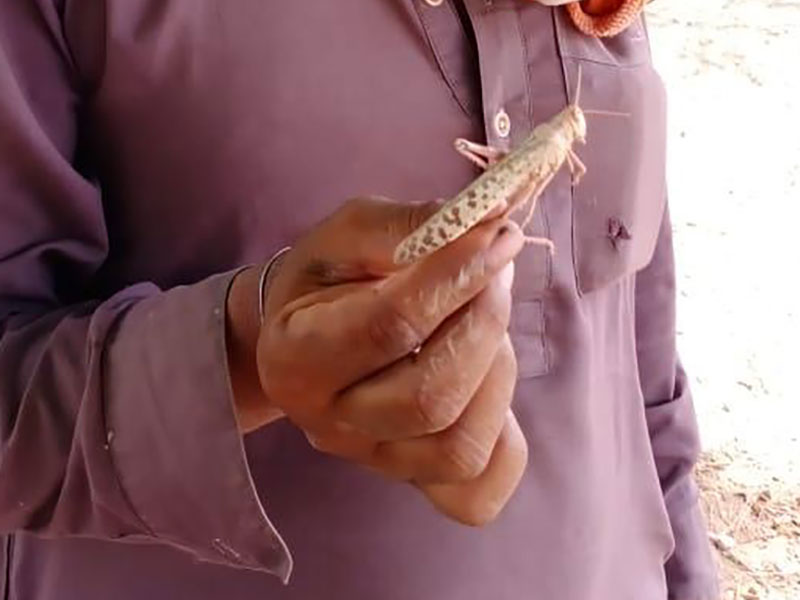Record Locust Swarms Hint at What’s to Come with Climate Change
Warming oceans that feed cyclones have also bred record-breaking swarms of desert locusts. Such plagues could grow bigger and more widespread with climate change.

Usually solitary, locusts become gregarious, or swarm, when there are heavy rains in an arid region. Desert locust swarms are highly destructive, sparing no greenery in sight.

This year’s locust attacks, which spread from Kenya to Pakistan and India, are the worst in the past 30 years and may be the most economically destructive since the 1960s, said Chaudhry Inayatullah, a former research scientist at the International Centre of Insect Physiology and Ecology in Nairobi, Kenya. The swarms are expected to peak this month, as a wetter-than-normal monsoon arrives, and to flourish as the rains continue through October.
Inayatullah and other locust experts fear that these attacks will only get worse. Climate change is altering the dynamics of pest control and reproduction, said Keith Cressman, the FAO’s senior locust forecaster. Changes in climate have led to increases in cyclones, which feed locust swarms with water and warmth.
Recent research also shows that human-induced warming may be intensifying a regional variability in an Indian Ocean pattern of warming and cooling called the Indian Ocean Dipole (IOD), sometimes nicknamed the “Indian Niño.” A more intense IOD could cause more frequent tropical storms and heavy rains. These rains create perfect conditions for locust breeding, with more water and warmth ideal for increased plant biomass to feed the locusts—which is what happened in 2019, when a record IOD led to above-average rainfall in the coastal areas of Somalia, Yemen, and some regions bordering the Red Sea.
During droughts, locust outbreaks do not occur in the region, mostly because of a lack of plants for the insects to eat. But higher temperatures associated with climate change coupled with increased availability of plants for food could speed up the locusts’ maturation and incubation during spring, Inayatullah said. This year, warmer temperatures have already allowed an extra generation of breeding to occur in northwest Africa, the Arabian Peninsula, and southwest Asia, amplifying the overall risk of a locust plague, the most serious category of locust threat identified by the FAO.
Perfect Storms for Locusts
“If this trend of increased frequency of cyclones in [the] Indian Ocean continues, then certainly, that’s going to translate to an increase in locust swarms in the Horn of Africa,” said Cressman. An increased number of cyclones in the past 3 years in the Indian Ocean played a role in the current upsurge. “In 2018, two cyclones dumped heavy rain on the uninhabited portion of the Arabian Peninsula known as the Empty Quarter. There, locusts can breed and reproduce freely. Three generations of breeding occurred in 9 months in the Empty Quarter, causing locust numbers to increase by 8,000 times.” Cressman said that outbreak is the source of the East Africa upsurge the FAO is warning about now.The swarms can jump oceans, and they leapt over the Red Sea and Gulf of Aden to the Horn of Africa late last year. “There, another cyclone in December 2019 triggered yet another spasm of reproduction that could give rise to two more generations of breeding—400 times the locusts,” Cressman said.

Heavy rains in Yemen and Saudi Arabia prompted the spread of locusts into Iran and Pakistan. They have also managed to breed in Pakistan’s Balochistan Province adjacent to Iran, are currently sweeping across the country’s southern agricultural belt, and have entered India across the Rajasthan desert. Drifting with the wind, some individuals have even been captured in Nepal. The FAO says the spring-bred swarms along both sides of the Indian-Pakistan border were poised to mature and lay eggs in early July, and new swarms will arrive from the Horn of Africa in mid-July.
Already, some farmers in Pakistan have reported up to 50% losses of their cotton crops. Ghulam Sarwar Panhwar, who owns two farms on around 120 hectares of land in the Hyderabad District of Sindh, said three locust attacks hit his farm in the past 3 months.
“Each time it is like a black cloud descending from the sky. There are millions of them, and they attack the cotton and other crops, eating all the green leaves in just 3–4 hours’ time before moving on,” Panhwar said. “Half of my cotton crop is gone. We chase them off by beating drums and banging metal plates. What else can we do?”
Aside from eating cash crops, the locusts are also consuming fodder plants, which will affect livestock.
Climate Controls
Meanwhile, the FAO has asked Pakistan and India to remain on high alert. India, Pakistan, Iran, and Afghanistan are all part of FAO’s Commission for Controlling the Desert Locust in South-West Asia. “Intercountry cooperation is needed to tackle the locust threat. Where they fly next depends on wind direction, speed, and other weather parameters,” Inayatullah said.

Accurate wind forecasts could be helpful to understand possible new landing sites, where aerial and ground spraying operations for pesticide applications could be readied in advance. Spraying in desert breeding areas in Pakistan has been underway since February, the region’s early spring, and could have its own set of ecological impacts.
The locust swarms eventually will dwindle in the cooler and drier winter months. No longer gregarious, “they will change back to their solitary phase,” Inayatullah said, “but by then they would have spread over vast areas and would have enough fat in them to stay alive even without food—until warmer weather arrives. This would be the ideal time to monitor and control them.”
—Rina Saeed Khan (@rinasaeed), Science Writer
No comments:
Post a Comment